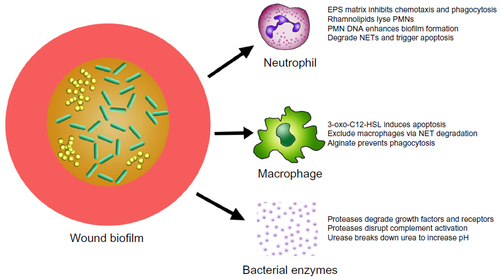Figures & data
Figure 1 Deleterious actions of biofilms in chronic wounds.
Notes: Bacterial biofilms are thought to delay wound healing for a variety of reasons, including reducing local oxygen levels, mechanically inhibiting granulation, increasing tolerance to antimicrobials, and shifting the immune response toward chronic inflammation. Interactions between bacterial biofilms and dying or ineffective neutrophils and macrophages appear to significantly contribute to the chronic inflammatory state seen in chronic wound infections.
Abbreviations: EPS, extracellular polymeric substance; PMN, polymorphonuclear neutrophil; NET, neutrophil extracellular trap; 3-oxo-C12-HSL, N-3-oxo-doedecanoyl-L-homoserine lactone.
Abbreviations: EPS, extracellular polymeric substance; PMN, polymorphonuclear neutrophil; NET, neutrophil extracellular trap; 3-oxo-C12-HSL, N-3-oxo-doedecanoyl-L-homoserine lactone.

Figure 2 The importance of managing pH in chronic wound infections.
Notes: The acidic pH of the skin is one of the key mechanisms that protect it from microbial infections. In wounds, increasingly alkaline pH is a predictor that they will become nonhealing or chronic. However, wounds that are too acidic are less likely to successfully accept grafts. The activities of most biological and enzymatic therapies have pH optimums, and numerous factors can shift wound pH including debridement and bacterial colonization.

